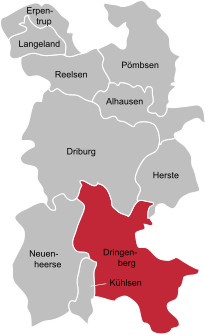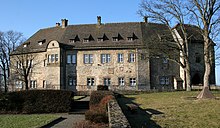Dringenberg
|
Dringenberg
City of Bad Driburg
|
|
|---|---|
| Coordinates: 51 ° 40 ′ 19 ″ N , 9 ° 3 ′ 24 ″ E | |
| Height : | 291 m |
| Area : | 22.73 km² |
| Residents : | 1764 (December 31, 2016) |
| Population density : | 78 inhabitants / km² |
| Incorporation : | 1st January 1975 |
| Postal code : | 33014 |
| Area code : | 05259 |
|
Location of Dringenberg in Bad Driburg
|
|
Dringenberg is together with Siebenstern a district of the city Bad Driburg in the district Höxter , administrative district Detmold , North Rhine-Westphalia . As of December 31, 2016, 1764 inhabitants live in Dringenberg, of which 1411 live in Dringenberg itself and 353 in Siebenstern. For centuries, Dringenberg with its castle was, alongside Paderborn and Neuhaus, the most important administrative seat in the Prince Diocese of Paderborn .
climate
Mainly south-westerly and westerly winds determine the climate, which is referred to as a "light stimulating climate". Due to the forests (Buchholz / Rietholz) and the altitude, there is no summer sultriness. Early morning fog forms in autumn. The long-term average rainfall is around 1150 mm. The average temperature in 2009 was 8.4 ° C.
history
| Capitals and cities of the Principality of Paderborn until 1802/03 (as of 1789): |
|---|
| Paderborn , Warburg , Brakel , Borgentreich | Beverungen , Borgholz , Bredenborn , Büren , Driburg , Dringenberg , Gehrden , Calenberg , Kleinenberg , Lichtenau , Lippspringe , Lügde , Nieheim , Peckelsheim , Salzkotten , Steinheim , Vörden , Willebadessen , Wünnenberg |
The hilltop castle Dringenberg belonged to the secular rule of the diocese of Paderborn , originally in the duchy of Saxony , since it was built from 1318 to 1323 . The castle was started under Bishop Dietrich II. Behind the expansion stood the secular Defensor Dietrichs Bernhard zur Lippe , who eventually became Prince-Bishop. In 1323 the settlement in front of the castle was granted city rights. From the 14th century the territory of the prince-bishopric of Paderborn ( Hochstift ) was formed in the Holy Roman Empire , and from the 16th century it became part of the Lower Rhine-Westphalian Empire .
In 1802/03 the bishopric was occupied by the Kingdom of Prussia . In Napoleonic times, Dringenberg was part of the Kingdom of Westphalia and the administrative seat of the canton Dringenberg, which in addition to Dringenberg included the villages of Schwaney , Altenheerse, Neuenheerse , Kühlsen and Willebadessen . From 1815 the place finally belonged to the Kingdom of Prussia. 1945–1949 Dringenberg was part of the British zone of occupation , from 1946 of North Rhine-Westphalia.
The actual importance of the place was always linked to its castle. From the 15th to the 17th century the castle was the seat of the Paderborn prince-bishops . Completely destroyed in the Thirty Years' War in 1636 , Prince-Bishop Dietrich Adolf converted the castle into a summer residence. Dringenberg was an important administrative seat within the prince-bishopric. If the Neuhaus residence was the seat of the head office for the Unterwald district , Dringenberg performed this task for the Oberwald district . The Dringenberg Oberamt was roughly identical to today's Höxter district, without the narrow area around Höxter / Corvey . The Dringenberg-Gehrden office also used the castle from 1825 as city and administrative authority until it was dissolved on January 1, 1975. Dringenberg was incorporated into the city of Driburg .
The small forest village of Siebenstern belongs to the Bad Driburg district of Dringenberg, first mentioned around 1300 under the name Elberinghausen . The place became known through the Siebenstern glassworks , an important production facility of the Principality of Paderborn. The place got its name around 1780 through a trademark of the glassworks.
politics
The district committee chairman of Dringenberg has been Meinolf Tewes (CDU) since 2009.
education
- Dringenberg Community Primary School
- Municipal kindergarten
Attractions
- Dringenberg Castle
- historical town hall
- The Church of the Nativity of Mary
- Scoop mill
- The Ösetal
- The Schonlau Chapel
tourism
Tourism is one of the most important sources of income for the village. In addition to the numerous sights and the landscape, which is particularly inspiring for artists, there are many hiking trails in this region, known as a hiking region, which wind through the Ösetal or lead past the rugged cliffs of the mountain on which the village is located.
The fish ponds in the vicinity of the village are of particular interest to anglers, as the rare Adriatic trout is only bred here in Germany and is often referred to by experts as the queen of trout due to its distinctive fin characteristics. The Obermühle legs offers accommodation to hundreds of anglers every year, but there are also overnight accommodations in the village center and in the west of the village.
The architecture of the medieval village is particularly eye-catching. The castle and the city wall in particular bear witness to the village's medieval past. The town hall was restored to its original Weser Renaissance style. Today it is one of the most important preserved buildings of this architectural style east of the Nethe.
Infrastructure and economy
The state roads L 820 (Burgstrasse) and L 953 (Zum Stadttor) run through the village . Buses of the Paderborn / Höxter local transport network on the R31 (Willebadessen-Dringenberg-Schwaney-Altenbeken) and 540 (Bad Driburg-Neuenheerse-Willebadessen) routes regularly cross the village. The federal road 64 is not far away and connects Dringenberg with the cities of Paderborn and Höxter.
The largest employer until 2013 was the company Walther-Glas (glass articles) with around 300 employees, which however was replaced by the local innkeeper and catering company "Zum golden Anker" after the bankruptcy and closure. The company currently has 31 employees (as of January 1, 2017) and forms a central economic pillar for the place. As a result of the operation, other shops are also settling in the village, such as the Dringenberg village shop. In addition, this also has an effect on the neighboring towns: For example, the Rheder beer sold by the company “Zum golden Anker” has been able to increase its sales significantly in recent years through the aforementioned restaurant, which means that the Rheder Brewery is now an established brewery nationwide.
The tithe barn in the town center serves as a local event space, for example for public meetings, for the shooting festival of the St. Sebastian shooting society in Dringenberg and for the Dringenberg carnival festival.
Personalities
- Ludwig Dringenberg (1410–1477), educator, humanist, cleric
- Hans Krako (1580–1627), goldsmith and creator of the Libori shrine in Paderborn Cathedral
- Michael Oestreich (* 1802 in Oberbimbach , † 1838 in Dringenberg), organ builder
- Lilli Schwarzkopf (* 1983) athlete, lives in the Dringenberg district of Siebenstern, silver medalist in heptathlon at the 2012 Olympic Games in London
literature
- Peter Bonk: Dringenberg . In: Josef Drewes (Ed.): The Hochstift Paderborn: Portrait of a region . Paderborn, 1997; Pp. 248-250. ISBN 3-506-95293-5
- Peter Bonk: Seven stars . In: Josef Drewes (Ed.): The Hochstift Paderborn: Portrait of a region . Paderborn 1997; Pp. 257-258. ISBN 3-506-95293-5
- Diether Pöppel: Dringenberg: City, castle and church through the years. 1980
- Dringenburg. In: Johann Heinrich Zedler : Large complete universal lexicon of all sciences and arts . Volume 7, Leipzig 1734, column 1460 f.
Web links
- dringenberg.de Private website about the district
- Parish of the Birth of Mary, Dringenberg
- Dringenberg in the Westphalia Culture Atlas
Individual evidence
- ↑ https://www.kreis-hoexter.de/unser-kreis/portrait/zahlen-daten-ffekten/m_3801
- ^ Federal Statistical Office (ed.): Historical municipality directory for the Federal Republic of Germany. Name, border and key number changes in municipalities, counties and administrative districts from May 27, 1970 to December 31, 1982 . W. Kohlhammer, Stuttgart / Mainz 1983, ISBN 3-17-003263-1 , p. 323 .
- ↑ Siebenstern was the longest existing glassworks in the Hochstift, cf. Alfred Heggen: State and economy in the principality of Paderborn in the 18th century. (= Studies and sources on Westphalian history; Vol. 17) Paderborn 1978, ISBN 3-87088-217-4 , p. 69.
- ↑ To the Golden Anchor
- ^ Rheder history. Retrieved April 25, 2017 .
- ^ Rheder beer
- ^ Rheder beer. Retrieved April 25, 2017 .
- ↑ Rheder Castle Brewery






